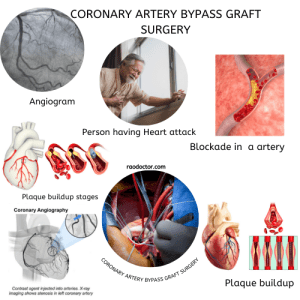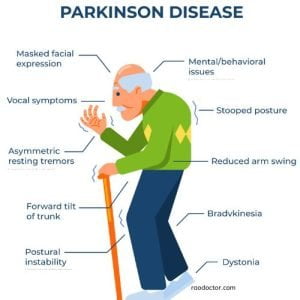Table of Contents
Frequently Asked Questions and Answers
Introduction
Coronary artery bypass graft (CABG) is a complex procedure that is often used to treat serious heart conditions. Some time back I had written an article on Minimally invasive CABG [MIDCAB]- you can read this here-
CABG is a major surgery that can dramatically improve the quality of life of those affected by heart disease. Despite its life-saving effects, many patients and their families are still unsure of what to expect from the procedure.
In this article, we will explore some of the most frequently asked questions about CABG and provide some practical answers. We will look at the risks and benefits associated with the procedure, the recovery timeline, and the long-term outlook for those who undergo CABG.
By the end of this article, you will have a better understanding of what to expect from CABG and how to prepare for it.
How do I know about Coronary Artery Bypass Graft (CABG)?
Back in 1983, after finishing my internship, I was posted as a resident doctor in Cardiovascular Thoracic Surgery department in BYL Nair Hospital, Bombay Central, Mumbai.
I did a stint of 6 months there, and believe me, the journey was tough but exhilarating. My job was to prepare the patient for surgery- counseling, taking the patient to OT, opening up the chest and after the surgery was over, closing it and waiting in the recovery room till the patient recovered from anesthesia.
In between the Cardiac surgeon would do the necessary surgery- valve replacement, repair of heart abnormalities or Coronary Artery bypass surgery.
During this period, I learned a lot about heart surgery. Today, in this article I am going to share that knowledge- the frequently asked questions about CABG.
What is Coronary Artery Bypass Graft (CABG)- how is it done?
Earlier I had written an article about prevention of a heart attack. Doing this is always better than having a surgery.
But, in spite of your efforts, you do suffer from a heart attack, you have an option to undergo either angioplasty or CABG. In this article, we will discuss the second option.
Coronary artery bypass graft (CABG) is a surgical procedure used to treat patients suffering from significant coronary artery disease.
It involves taking blood vessels from other parts of the body and connecting them to the coronary arteries to improve blood flow to the heart. CABG can be used to treat all stages of coronary artery disease, from mild to advanced.
Depending on the severity of the patient’s condition, CABG may be used in conjunction with percutaneous coronary intervention (PCI).
Coronary artery disease occurs when the blood vessels in the heart (coronary arteries) become blocked with cholesterol and other fatty deposits, leading to poor blood flow.
The main arteries that provide blood to the heart are the left anterior descending (LAD), the left circumflex (LCX), the right coronary, and the right descending arteries (RDA).
CABG is used to bypass these narrowed or blocked arteries by connecting blood vessels from other parts of the body to the coronary arteries.
CABG can improve blood flow to the heart, reducing the risk of heart attack, heart failure, and sudden cardiac arrest.
For a detailed knowledge, you can watch this video-
HOW TO DECIDE IF YOU NEED A CABG?
If you have recently developed chest pain and an angiography report shows blockades in your coronary arteries, then you need either angioplasty [non-invasive procedure putting a stent in your artery to improve blood flow] or CABG.Depending upon some tests called Cardiac markers, we can make out if a heart attack has occurred. Depending upon these markers, the decision to carry out CABG is taken. These are some cardiac markers and their normal values that your doctor may suggest [please refer to the table on the right]-

You can refer to this article to learn more about Cardiac Markers.
Your doctor may also suggest you get a TMT- Treadmill ECG- to rule out if you have ischaemia (the blood supply to heart is low).
Apart from these tests, your doctor will suggest you undergo coronary artery angiography- a test to know which of your arteries are diseased or blocked [see above].
What are the risks associated with CABG?
As with any major surgery, CABG carries some risks, such as infection, bleeding, and blood clots. Some patients may also experience long-term complications in the areas of the body where blood vessels were harvested for the procedure. CABG may expose to these risks-
Heart Attack: There is a possibility that the artery that was used for the bypass graft may become clogged. If this happens, it could result in a heart attack. A heart attack is caused by a blockage of blood flow to the heart. If a patient experiences pain in the chest, sweating, nausea, or any other symptoms that indicate a heart attack, they should seek medical attention immediately.
Heart Failure: This is when the heart can no longer pump blood effectively, often due to a build-up of fluid in the lungs and other tissues. CABG does increase the risk of heart failure, but only in patients who have other risk factors for this condition, such as high blood pressure or high cholesterol.
Low Blood Flow: When the coronary arteries are bypassed, the blood flow to the areas of the heart that are not connected to the new grafts may be reduced. This can lead to angina, shortness of breath, or leg pain (also known as claudication).
Blood Clots: Blood clots can form at the site where the new bypass grafts are connected to the coronary arteries. These clots can break off and travel to the brain, causing a stroke. Blood thinners can help reduce the risk of blood clots, but they come with some side effects.
What are the benefits of CABG?
CABG improves blood flow to the heart and can reduce the risk of future heart attacks, heart failure, and sudden cardiac arrest.
It can also extend the lifespan of a patient’s heart by reducing the amount of wear and tear on the heart. CABG can also eliminate the need for stents, which are small metal scaffolds used to prop open narrowed arteries.
These devices can become blocked over time, requiring patients to undergo multiple stenting procedures to unblock the arteries.
CABG is considered a more permanent solution to coronary artery disease than stenting.
While stents can be unblocked or removed, bypass grafts are intended to remain in the coronary arteries permanently.
What is the timeline for recovery after CABG?
In general, the recovery timeline for CABG will depend on the patient’s overall health, their operation type, and the extent of their cardiac disease.
It is important to note that CABG is a major surgery and will result in a longer recovery time than percutaneous coronary intervention (PCI) or angioplasty.
Patients are usually able to walk around the same day of their surgery and can usually go home after a couple of days.
Patients may need to stay in the hospital or at home for a couple of weeks before they are able to return to work.
It is also important to note that each patient’s recovery timeline will be unique and will vary from person to person.
What is the long-term outlook for those who have undergone CABG?
The long-term outlook for patients who have undergone CABG is generally positive. If a patient has a healthy lifestyle, their outlook will be better than someone with a bad diet and no exercise.
CABG patients should follow a healthy diet, exercise regularly, and take their medications as prescribed to avoid complications.
By taking good care of themselves, CABG patients can expect to live a longer, healthier life. CABG patients should be aware that they have a slightly higher risk of dying than patients who have undergone PCI.
This is because CABG is a more invasive procedure than PCI. CABG patients are also at a higher risk of developing long-term complications, such as heart failure and cognitive impairment.
What are the common complications associated with CABG?
As with any major surgery, CABG can result in complications. These include infections, blood clots, blood loss, abnormal heartbeat, and cardiac arrhythmia.
Patients can reduce their risk of complications by following their doctor’s post-operative instructions and making healthy lifestyle choices.
Bleeding: Bleeding is a risk of any surgical procedure and can usually be controlled with medication. However, excessive bleeding can be very serious and may require surgery to stop the bleeding.
Cardiac arrhythmia: Patients can experience an abnormal heartbeat following CABG. Typically, this is not a serious condition and can be treated with medication.
Lung infections: Patients can develop lung infections after CABG, particularly if they have another condition that leaves them susceptible to infections, such as diabetes or COPD.
How can I prepare for CABG?
As I have said earlier, my job as a resident doctor was counseling the patient and this what I used to tell them-
Before you undergo CABG, you should make sure that you are as healthy as possible, both physically and mentally. This will greatly increase your chances of a successful outcome and a speedy recovery.
Take these steps to prepare for CABG:
1.Manage Your Health Conditions: Pre- operatively, make sure that you have properly treated any health conditions that you may have, such as high blood pressure, diabetes, or high cholesterol.
2.Manage Your Medications: Make sure that you understand all the medications that you take and the side effects associated with them. Some medications can make the healing process take longer and may increase the risk of complications.
3.Manage Your Stress: Stress can negatively affect your health and can increase your risk of complications. Practice relaxation techniques such as mediation or yoga to lower your stress levels. Any type of surgery is stressful for the patient and CABG all the more, as it is a major surgery.
4.Manage Your Weight: Being overweight or obese can increase your risk of developing coronary artery disease. If you are overweight, diet and exercise can help you lose weight and reduce your risk of heart disease.
What questions should I ask my doctor before I undergo CABG?
Before you undergo CABG, make sure that you are fully informed about the procedure and what to expect. This will help to reduce any anxiety that you might have about the procedure. Here are some questions that you should ask your doctor before undergoing the treatment.
If you are considering CABG surgery, it is important to ask your doctor several questions so that you can make an informed decision.
Before undergoing CABG, make sure that you have a clear understanding of the procedure, any risks associated with it, and what you can expect before, during and following the surgery.
Here are some questions you should ask your doctor before CABG surgery:
What is the reason for suggesting CABG surgery?
Make sure you have a full understanding of why your doctor is suggesting CABG and how it will benefit you.
What are the risks associated with CABG?
Ask your doctor to go over the potential risks associated with CABG, such as infection, stroke, and heart attack.
What type of CABG will be done?
There are 2 types of CABG, so make sure you understand which one your doctor is proposing.
How long will the surgery take and how long will I stay in the hospital?
Ask your doctor to give you an estimate of how long the surgery will take and how long you can expect to stay in the hospital.
What sort of lifestyle modifications will I need to make after the surgery?
Ask your doctor what lifestyle changes you need to make after CABG, such as quitting smoking, exercising regularly and eating a healthy diet.
What type of follow-up care will be required?
Ask your doctor what type of follow-up care is necessary after CABG, such as regular check-ups and tests.
These are just a few of the questions you should ask your doctor before undergoing CABG surgery. By arming yourself with knowledge, you can ensure that you are making an informed decision about your health.
Finally
I hope this article has been helpful to you in understanding coronary artery bypass surgery. If you have found it useful, do share this knowledge with your friends and family members through the social media icons at the bottom of this article and/ Click to Tweet-
Unravelling the Mysteries of Coronary Artery Bypass Graft (CABG) Share on X



